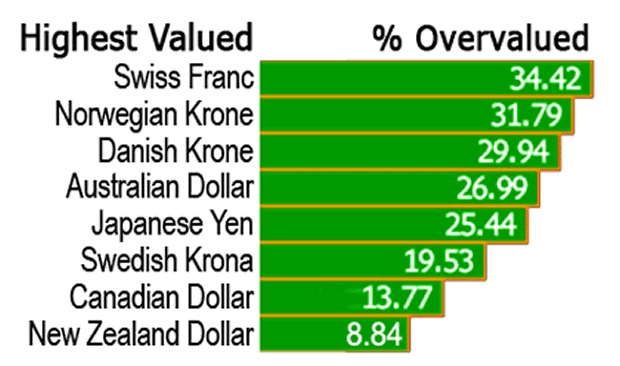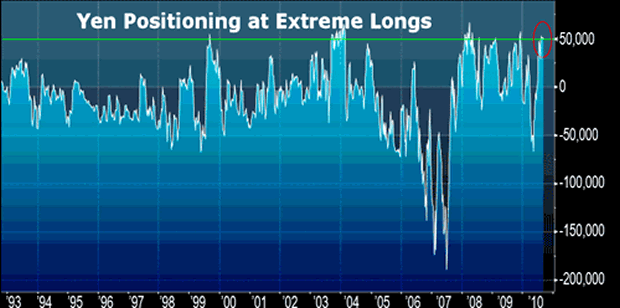Biggest Ever Yen Intervention, 25% Over Valued Agains the Dollar
Currencies / Japanese Yen Sep 19, 2010 - 10:42 AM GMTBy: Bryan_Rich
 Last week, I pointed to the challenges facing Switzerland and Japan’s currencies. As for the yen, I said that nothing short of actual intervention would relieve the pressure on its exporters. I also said that I expected it to happen.
Last week, I pointed to the challenges facing Switzerland and Japan’s currencies. As for the yen, I said that nothing short of actual intervention would relieve the pressure on its exporters. I also said that I expected it to happen.
And it did.
Japan intervened this week to stop the ever-rising yen, its biggest one-day intervention on record. But many in the foreign exchange market believe the effort will fail — and ultimately a strong yen will win out.
I disagree.
First, I can’t think of one fundamental argument that would support the case for a stronger yen.
Second, Japan has every incentive to keep intervening.
Remember, this is a country attempting to weaken its currency, not save it from a death spiral of weakness.
Given that fact, unilateral currency market intervention by Japan works in their favor in several ways …
It softens the currency burden for its all-important exporters.
And it requires Japan to print more and more yen, ultimately easing monetary policy even further. Indeed, a move needed in Japan’s fight against another round of deflation.
So what do they do with all of the freshly printed yen?
They sell it and buy U.S. dollars. That means they stockpile currency reserves … an area commonly perceived to be a gauge of a country’s financial wealth and stability.
Perhaps even more favorable: It’s a politically-positive move. For a country that’s had six prime ministers in the past five years — nearly seven in the wake of last week’s elections — stepping up to the plate to weaken the yen is a political win.
Why Japan’s Intervention Will Work
Because of the incentives I discussed above, I expect Japan’s efforts to persist and pay off. But when you add in four more pieces of supportive evidence, the case is even stronger that we may have seen a long-term top in the yen.
Supportive Evidence A: The yen is way overvalued
Below is the OECD’s measure of the most overvalued currencies based on Purchasing Price Parity (PPP). As you can see the yen is among the most overvalued currencies in the world, more than 25 percent too rich against the dollar.
|
Supportive Evidence B: The long yen trade is overcrowded
The chart below shows the massive build up of long positions in the yen, a dynamic that typically doesn’t end well for those on the side of an extremely overcrowded position once the selling begins.
|
Supportive Evidence C: History of successful intervention
The only other time the yen was this strong against the dollar was in 1995. The yen traded as high as 79.75 against the dollar before the Bank of Japan stepped in, sending it 46 percent lower over the next three years … and in the process marking the all-time high for the yen.
Supportive Evidence D: Debt, debt and more debt
Japan’s debt load is twice the size of its economy. The Bank of International Settlements projects that by 2040 it will reach 400 percent of GDP.
As I detailed in my May 15 Money and Markets column, Japan: The Sleeping Sovereign Debt Giant, Japan faces big structural shifts that will likely make it difficult to internally finance its debt much longer. It will soon have to start competing for international capital to fund its debt. And given its non-competitive interest rates, that raises the specter of default.
|
In fact, Standard and Poor’s said this week the risk of a sovereign debt default in Japan is “slowly increasing.” This fundamental problem in Japan will ultimately result in a much weaker yen.
What Does this Mean For the Rest of the World?
Japan’s intervention could be just the first step in a long, sharp devaluation of the yen. And in a world where unsustainable debt and deficits are prevalent and economies are fragile, this could ignite a wave of currency devaluations in other countries.
Already, Japan’s move has started speculation that countries like South Korea, Singapore and Thailand could follow suit.
Bottom line: This intervention could mark the beginning of increased global currency risk, another round of capital flight from high-risk currencies and another, more sustained, period of global risk-aversion.
Regards,
Bryan
P.S. For more news on what’s going on in the currency markets, be sure to check out my blog, Currencies Corner. You can follow me on Twitter, too, and get notified the moment I post a new message.
This investment news is brought to you by Money and Markets. Money and Markets is a free daily investment newsletter from Martin D. Weiss and Weiss Research analysts offering the latest investing news and financial insights for the stock market, including tips and advice on investing in gold, energy and oil. Dr. Weiss is a leader in the fields of investing, interest rates, financial safety and economic forecasting. To view archives or subscribe, visit http://www.moneyandmarkets.com.
© 2005-2022 http://www.MarketOracle.co.uk - The Market Oracle is a FREE Daily Financial Markets Analysis & Forecasting online publication.
Comments
|
kuzotz
30 Dec 10, 05:11 |
you disagree?!?!?
The strong yen has won out, so now what? |






